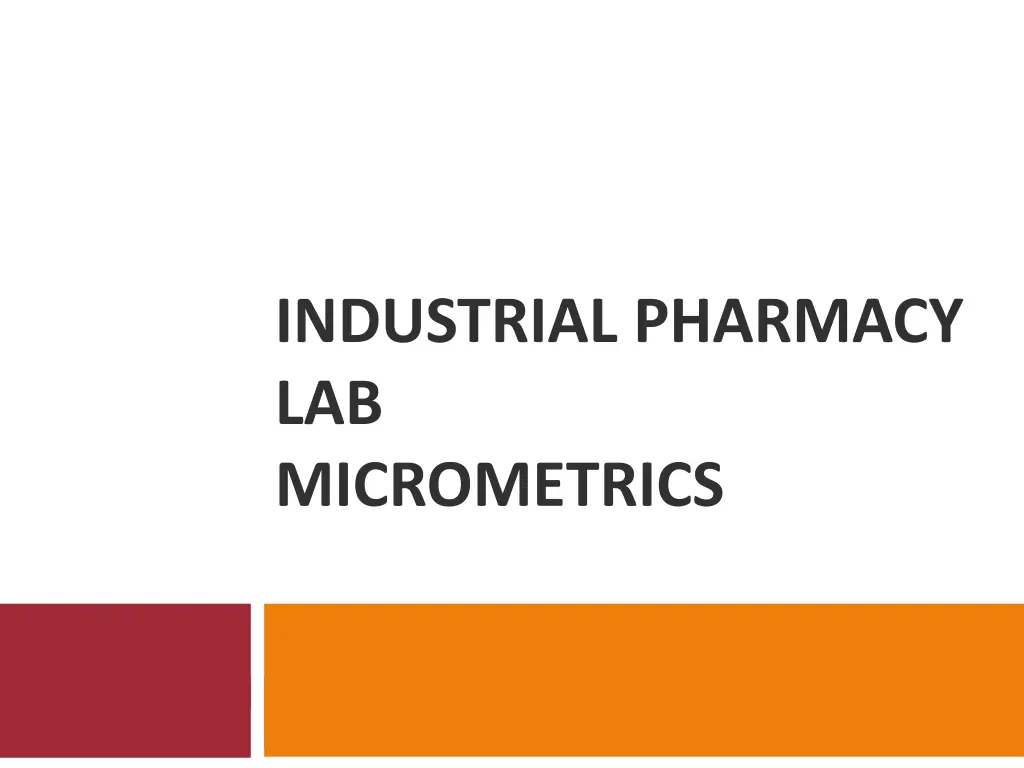
Particle Size Analysis in Industrial Pharmacy Lab
"Explore the significance of studying particle size in industrial pharmacy labs, including insights on micromeritics, particle characteristics, methods for analysis, and importance for drug formulation and stability."
Uploaded on | 1 Views
Download Presentation

Please find below an Image/Link to download the presentation.
The content on the website is provided AS IS for your information and personal use only. It may not be sold, licensed, or shared on other websites without obtaining consent from the author. If you encounter any issues during the download, it is possible that the publisher has removed the file from their server.
You are allowed to download the files provided on this website for personal or commercial use, subject to the condition that they are used lawfully. All files are the property of their respective owners.
The content on the website is provided AS IS for your information and personal use only. It may not be sold, licensed, or shared on other websites without obtaining consent from the author.
E N D
Presentation Transcript
INDUSTRIAL PHARMACY LAB MICROMETRICS
Micromeritics 2 Micrometrics: Science of small particles Particle: the smallest unit of matter having defined physical dimension.
Micromeritics 3 Why study particles? Most drug dosage forms are solids Solids are not static systems physical state of particles can be changed by physical manipulation alter the therapeutic effectiveness
Micromeritics 4 Particle size Particle shape Bulk volume Flowability
Micromeritics - Bulk volume 5 Used to calculate bulk density
Micromeritics - Flowability 7 The ease with which a powder will flow under a specified set of conditions. Some of these conditions include: 1. The pressure on the powder, 2. The humidity of the air around the powder 3. The equipment the powder is flowing through or from
Particle Size Analysis 8 Why we do particle size analysis? Bioavailability: particle size controls the dissolution rate particle size dissolution rate Stability: especially for suspensions where the rate of settlement is directly related to the particle size. Formulation: the particle size affects formulation behavior during processing, and ultimately the content uniformity of the formulation 1. 2. 3.
Determination of Particle Size 9 Particles are not uniform in shape complicate particle size determinations The selection of suitable technique depends on: 1. Solubility 2. Ease of handling 3. Time restrictions
Methods for measuring particle size 10 Microscopic method Sieving method Coulter counter method Sedimentation method 1. 2. 3. 4.
Microscopic Method 11 Use a calibrated ocular microscope to count a minimum of 200 particle in a single plane. The particle size usually between 0.2 100 m.
Microscopic Method 12 Advantage of microscopic method: We can examine each particle individually Disadvantages of microscopic method: We measure two dimensions only Time consuming and need an experienced staff. 1. 2.
Sieving Method 13 Use set of standard sieves arranged in descending order: 1.The powder is placed in the top sieve and the sieves are shaken . 2.The quantity of powder remaining on each sieve are weighed.
Sieving Method 14 Sieves can be referred by their size or by mesh size Mesh number: number of square opening across 1 inch of screen Typically 90% or more of the particles will lie within the indicated range.
Sieving Method 15 Factors affecting sieving method 1. Sieve loading 2. Agitation duration 3. Agitation intensity
Sieving Method 16 Advantages of sieving method: 1. Easy to perform. 2. Wide range of sizes can be obtained. 3. Inexpensive Disadvantage of sieving method: 1. Wear and damage to the sieve. 2. Weight loss. 3. Particles with irregular shape will be difficult to measure.
Coulter Counter Method 17 A particle is suspended in conducting liquid and passed through a small orifice. This orifice has electrodes on either sides. As particle passes, it displaces its own volume of electrolyte and a change in electric resistance occurs This change is amplified and calibrated in term of particle size.
Coulter Counter Method 18 Advantages: 1. True volume of distribution. 2. Wide range measurement 0.5 400 m. 3. Very fast, can count 4000 particle per second.
Sedimentation Method 19 Gravitational sedimentation (originally the pipette method) measures the settling rate of particles in liquid medium and relates this rate to the particle mass by use of the Stokes law.
Sedimentation Method 20 The settling rate during sedimentation analysis is determined by measuring x-ray transmission in the liquid at specific heights and time intervals Particle size distribution based on difference in mass is calculated. Allows high-resolution measurements within a relatively short time frame.
Experimental work 21 Measure particle size and size distribution of a powder using 2 methods Submit a report with you results Discuss your results with lab instructors 1. 2. 3.
24 Particle size distribution When the number or weight of particles lying within a certain size range is plotted against range or mean particle size, the resulted curve called frequency distribution curve
25 frequency distribution curve Normal distribution curve is symmetrical about vertical axis but most pharmaceutical distribution are asymmetrical.
26 The plot gives a visible representation of particle distribution that an average diameter cannot achieve. It is possible for two sample to have the same average diameter but different distribution. In addition. By having a quick look on the curve, one can have an idea about which particle size occurs most frequently within the
